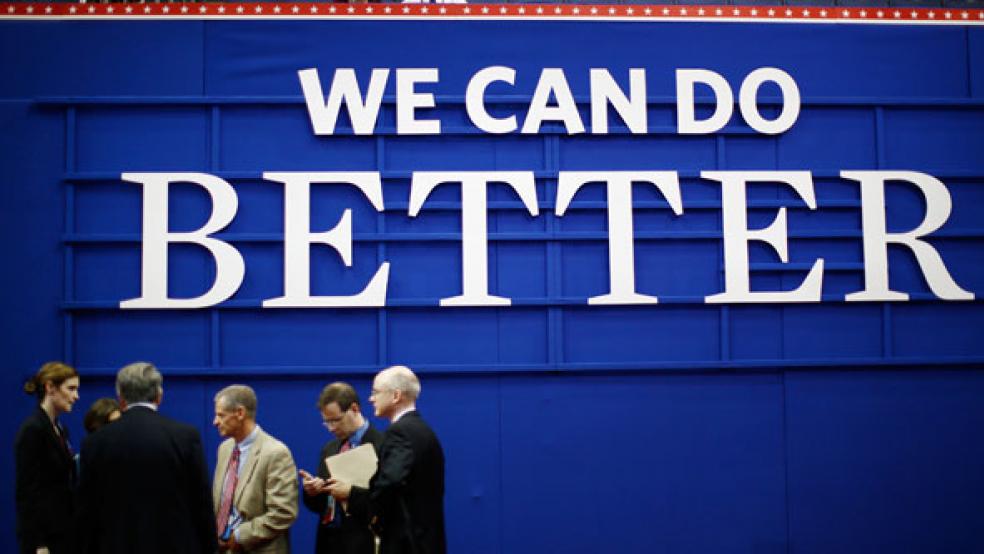Delegates to the Republican national convention will adopt a platform on Tuesday that represents a major triumph for the economic and social conservatives that make up the party’s activist base. The final document, which includes calls to radically transform every entitlement program, moves the party well to the right of where it stood four years ago.

Standard-bearer Mitt Romney has already begun distancing himself from some of the more controversial elements of the document, such as the call to ban abortion under all circumstances, including pregnancies that result from rape or incest. But he has largely embraced many of the platform’s controversial economic planks, such as turning Medicare into a premium support program, establishing private accounts for Social Security and making sweeping changes in the tax code that analysts say would provide most of its benefits to the nation’s richest families.
While he endorsed those planks in phrases that leave him plenty of wiggle room as the campaign unfolds, Democrats and the Super PACs that support them are already highlighting those platform elements in campaign ads in key swing states. That could undermine the carefully crafted image that Romney hopes to present to voters this week and for the remainder of the campaign: That his business experience makes him the Mr. Fix-It that the economy needs.
“Romney is taking a big gamble,” said Norm Ornstein, a senior fellow at the American Enterprise Institute. “The platform gets in the way of his moving to the center. The more (people) focus on the platform, the less he’s able to focus on redefining his campaign.”
The political task for Romney is straightforward. For most of the first half of the year, he catered to the most conservative elements in the country to win Republican primaries. Then he absorbed a summer of withering attacks by President Obama for his role as a “job destroyer” at Bain Capital. The convention script recasts the former Massachusetts governor as a centrist problem solver who will create jobs. Fence-sitting voters in the handful of states where the election will be decided – though a shrinking share of a polarized electorate – will likely cast their ballots for the candidate they think is best suited to get the nation’s economy moving again.
In any year when the workforce is suffering through an 8 percent-plus unemployment rate, projecting that message should not be a problem. And Romney, like his opponent, will have hundreds of millions of dollars to pour into ads in the final months of the campaign to get that message across, which will be supplemented with hundreds of millions more spent by Republican-leaning Super PACs, which have outraised Obama-leaning Super PACs by a 3-to-1 margin.
As Romney adviser Eric Fehrnstrom put it last March: “Everything changes” after the candidate gets the nomination. “It’s almost like an Etch A Sketch. You can kind of shake it up and we start all over again. The problem now, though, is that the platform writers threw a monkey wrench into the Etch a Sketch machine.
ENTITLEMENTS
The candidate began the process with his choice of Paul Ryan as his running mate. The Congressman from Wisconsin and chairman of the House Budget Committee has authored three plans to turn Medicare over to private insurance companies while fixing the amount the government will give future seniors to buy those plans. Ryan’s latest effort modified his earlier plan, which would require future seniors (those under 55 years old now) to pick up nearly two-thirds of their health care costs, according to a Congressional Budget Office analysis.
While Romney has not said which of those plans he would back – he has endorsed the general concept as the best way to rein in government spending when health care costs spiral upwards, as they inevitably will with the retirement of the Baby Boom generation. The platform also endorsed that approach.
The platform also touched on Social Security, which was once considered the third rail of American politics and an issue that helped the Democrats win control of Congress in 2006. “Republicans are committed to setting it on a sound fiscal basis that will give workers control over, and a sound return on, their investments,” the platform said, a refrain of the proposal that President George W. Bush made in 2005. CBO projects Social Security will be insolvent by 2033. Expect to hear a lot more about that plank on the campaign trail from Democrats.
The current program pools all payroll taxes and pays benefits to every retiree from that pool. Giving workers control over their own accounts – the equivalent of a national 401(k) or 403(b) program – would transfer some of the payroll tax into individual accounts that could then be invested in stocks, bonds or other investment vehicles that would be subject to the vicissitudes of the market.
DEFENSE
Elsewhere on the spending side, the platform calls for ramping up defense spending for a second consecutive decade, despite the winding down of wars in Iraq and Afghanistan. The plank was adopted over the protests of delegates pledged to Texas Congressman Ron Paul, who has somewhere between 150 and 200 delegates in Tampa. They believe, like many on the left wing of the Democratic Party, that the U.S. needs to reduce its footprint abroad and curtail wasteful Pentagon spending.
Romney has called for an 8 percent increase for the Pentagon, which over the next decade would substantially increase the military’s share of the overall economy. He and the platform writers also called for a stronger military footprint in the Far East to counter China, which is seen as a rising military as well as economic threat, and they promised a tougher stance on Iran in the Middle East.
While Romney is a knowledgeable financier who understands the need for countercyclical economic policies during economic crises and recessions, his party’s platform this year – as in the past – called for a constitutional amendment to balance the budget. A separate plank sought an amendment that would allow Congress to pass tax increases only with a “super majority” of more than 60 votes in the Senate except in times of war or national emergencies.
TAXES
Romney would kick off the coming era of government austerity by lowering tax rates on corporations and individuals by 20 percent. A report from the Tax Policy Center estimated his plan would distribute most of its tax relief to families in the top tax brackets.
Tax cuts and higher military spending in the context of attempting to balance the budget can only be accomplished with either dramatic cuts in all other domestic programs or increases in middle class taxes. Romney has said he is for eliminating some tax preferences although he won’t say which ones. The platform backed away from a proposal to scale back the home mortgage deduction.
“It’s impossible in the midst of a campaign to educate voters,” said Douglas Holtz-Eakin, a former CBO director who now is president of the American Action Forum and a Romney adviser. “Calling for low marginal rates and a broader base is the right way to message this during a campaign.”
Republican pollsters say the American people are ready for many of the far-reaching changes contained in the platform and will look past specific elements that don’t add up or are even contradictory. “The majority of Americans think this country is in decline right now,” said John McLaughlin, a Republican pollster. “They know we need serious reforms.”





